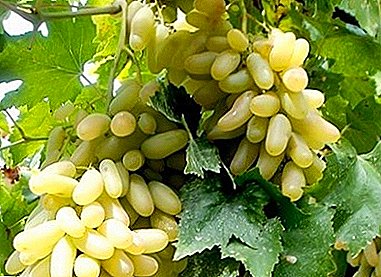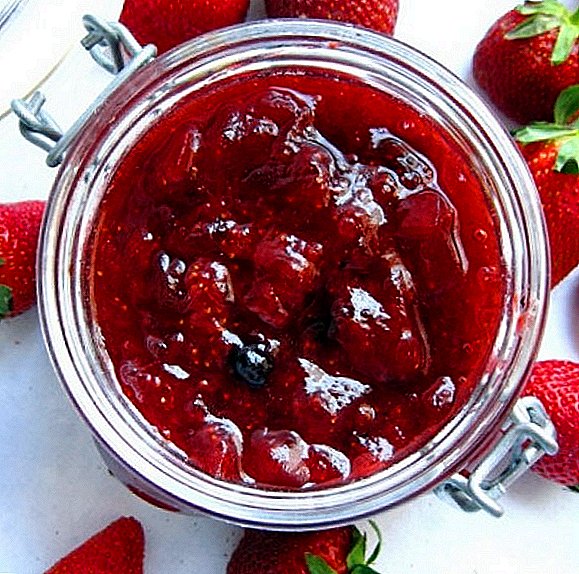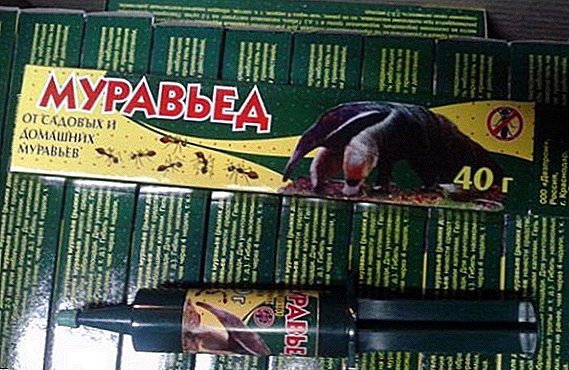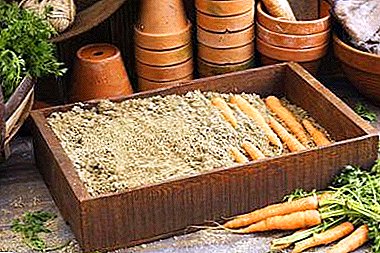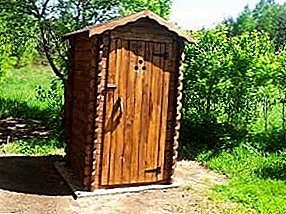
The subspecies of broilers (or crosses) unites several breeds of meat orientation, which are deservedly popular both in private farms and on large farms. The benefits of broiler breeding are explained by their fast weight: in 2 months the individual reaches a slaughter weight.
Growing and maintaining crosses has some differences from the breeding of ordinary laying hens. Thanks to this article, we will learn to grow broilers at home.
Characteristics, differences and complexity of the content
 Broiler is a hybrid of domestic chicken that is bred when crossing several breeds. Crosses differ from ordinary birds in early maturity. Because of early slaughter, broilers do not live to the onset of egg production.
Broiler is a hybrid of domestic chicken that is bred when crossing several breeds. Crosses differ from ordinary birds in early maturity. Because of early slaughter, broilers do not live to the onset of egg production.
In the list of other characteristic features, there are:
- large sizes (roosters - up to 6 kg, hens - 4-5 kg);
- wings and feet short;
- intensive weight gain;
- weak activity;
- high need for food.
REFERENCE! Unlike domestic hens, broilers are grown mainly in cages. This growing technology maintains high productivity. Minimum movements and bright light - the basic conditions for the health and growth of individuals.
The complexity of the content lies in the special demands of the crosses to the surrounding conditions. Chickens should be kept in a room where the air temperature is not lower than 30 degrees. From the second week, this figure is reduced to 26. In the first days of life, it is important that the light in the chicken coop burns constantly (guaranteeing a stable weight gain).
A prerequisite for proper maintenance is good ventilation and cleanliness, since broilers do not move much, and dampness provokes dangerous diseases in them.
A few words about the rocks
Contrary to the prevailing stereotype, a broiler is not a breed, but a subspecies. Every year, breeders work on breeding new highly productive breeds. To do this, select the largest, most resistant and healthy birds. Over the past year 3 breeds have been bred.
- COBB-500. These crosses reach the minimum slaughter weight in 6 weeks (weighs 2-2.5 kg). Features - yellow skin, disease resistance, high survival rates. Chickens have large paws and a wide breast.
- ROSS-308. The breed is distinguished by an incredible growth: for a day the chicken is gaining 40-60 g. The meat is paler than that of COBBs, but the breast is wider and fleshy.
- ROSS-708 - the leader in the list of new breeds. Young in the first month weighs 2.5 kg. The skin color has a yellowish tint.
How to choose the right eggs?
 One of the important components of growing crosses - the choice of high-quality eggs for incubation. Experienced farmers advise buying eggs from a medium-sized layer.her age should not exceed 2 years (the optimal age is 8-10 months). The hatching egg has the correct shape, uniform shade and average weight. It is advisable to choose the same size eggs - this is a guarantee of the simultaneous appearance of chicks.
One of the important components of growing crosses - the choice of high-quality eggs for incubation. Experienced farmers advise buying eggs from a medium-sized layer.her age should not exceed 2 years (the optimal age is 8-10 months). The hatching egg has the correct shape, uniform shade and average weight. It is advisable to choose the same size eggs - this is a guarantee of the simultaneous appearance of chicks.
To lay in the incubator can not take large eggs - they have a thin shell, which can form small cracks. And through the slightest damage inside the egg (to the embryo) infection easily penetrates.
Store eggs before laying in the incubator can be no longer than 3 days. A longer period increases the risk of developing various deviations in the health of the young. It is better for novice poultry farmers to buy not eggs, but day-old chicks - this will save time, finances and strength for independent hatching.
Nutrition
Growing individuals for meat requires strict compliance with the feeding scheme, selection of a balanced diet and adherence to daylight hours. During the period of weight gain, crosses require enhanced nutrition. Fattening should begin from the first days of the chicken's life. Millet and boiled eggs can be given to youngsters; from the fourth day of life, greens and mash must be introduced. Adult birds are fed feed, food waste, mineral additives.
Chick care
When choosing chickens, it is better to stop your choice on individuals that are already 10 days old. Daily crosses more difficult to tolerate transportation and long adapt to new conditions.
Age from zero days
The first thing that chicks should get after hatching is a few sips of sweet water. In 1 liter of warm water should be diluted 1 tsp. sugar and water the chickens. Then you should give them a portion of boiled egg. The basis of the diet in the first 5 days is low-fat cottage cheese, a mixture of feed and eggs. Crystals of potassium permanganate should be added to the water for drinking. Separately, 2 times during this period, the chicks should be given an aqueous solution of glucose.
10-20 days
 Individual feed starter feed. Give it to the chicks in a moist form with the addition of greens, buttermilk or yogurt (onion ratio and feed 1:20). Chives have an antiparasitic effect in the intestines. Over time, the percentage of green in the diet should rise to 10.
Individual feed starter feed. Give it to the chicks in a moist form with the addition of greens, buttermilk or yogurt (onion ratio and feed 1:20). Chives have an antiparasitic effect in the intestines. Over time, the percentage of green in the diet should rise to 10.
You can also mix crushed shells, grated carrots into the feed. From 10 days you need to make a vaccine against infectious diseases. For the prevention of coccidosis on day 14, Baycox is injected into the body (1 g per 2 liters of water).
In the period from 10 to 14 days the probability of a mass case is high. For prophylaxis, it is necessary to use antibiotics for 4 days. In water for drinking should add a couple of drops of iodine. After completion of antibiotics, you need to take a break for 3 days, and then give multivitamin complexes to individuals.
Monthly chicks
At this age, young animals are transferred to granulated feed (in its composition, cereals, protein, amino acids). Greens are not removed from the diet.
Alternative to compound feed - independently prepared mixture:
- crushed grain (wheat, barley, peas in equal amounts);
- fish oil granules;
- fish or bone meal;
- a few drops of whey to moisten.
Stir the ingredients until smooth. Then add chopped greens (onion, cabbage, lettuce) to the mixture. Suitable temperature in the house for monthly chicks is 23 degrees, the length of daylight is 14 hours.
45-50 day individuals
Preferably whole grain feedingas the mixed feed reflects badly on the taste of meat. Pour the grain in the trough needed along with shells, chalk. Once every few days it is advisable to cook porridge from small fish, herbs, wheat (components insist up to 3 hours). From 45 days it is forbidden to give broilers any medicine.
Breeding adult broilers at home
It is possible to grow adults in several ways, each of which has its own nuances. For the maintenance of broilers are often used cages or specially equipped pens.
Cellular content
 The option is best suited for breeding crosses in a small area (in the country, in the yard). Broilers have a phlegmatic character and normally feel in tight space. The content of 1 individual in a cage is unprofitable from the sanitary and hygienic requirements (if one individual is sick, the infection spreads to the entire herd).
The option is best suited for breeding crosses in a small area (in the country, in the yard). Broilers have a phlegmatic character and normally feel in tight space. The content of 1 individual in a cage is unprofitable from the sanitary and hygienic requirements (if one individual is sick, the infection spreads to the entire herd).
The density of planting broilers in a cage should be as follows:
- for chickens - 18 individuals per 1 sq. m;
- adult birds - 9 heads per 1 sq.m.
It is recommended to make cells for keeping 3-5 crosses in them. In one cage you can keep no more than 10 heads. Birds should have simultaneous access to the feeder. Attach it to the front wall, the water bottle should be placed above the feeder. Be sure to make them removable to allow flushing. Cells are allowed to be reused, but before placing a new batch it is important to process and disinfect them.
In the pen
An ordinary shed is suitable for this method, in which part of the area is fenced by a folding fine-meshed net. No more than 10 individuals should be placed in 1 pen. If the livestock is large, for each ten a separate section is made. Inside the pen is equipped with drinkers and feeders. The floor is recommended to be covered with a mixture of sawdust, chips and peat. It is not necessary to use straw, as it can cause an outbreak of aspergillosis.
Tips for beginners
It does not make sense to keep a broiler for more than 2 months, as growth slows down, and the need for feed remains high. The bird consumes a lot of food, its meat becomes tasteless and tough over time.
Growing more than 2 months is advisable only for offspring. For these purposes, healthy and resistant individuals (2 females and 2 males) should be kept.
What else is important for a newbie to know:
- The requirement for the room - warmth, dryness, clean bedding on the floor.
- Regular processing of the house. Walls and ceilings must be treated with lime or special disinfectants.
- Balanced diet and day regimen.
- Timely vaccination.
Feeding Details
 At home breeding the bird is fed feed, as it contains the necessary elements for active growth. Broilers eat well a wet mash with sugar, crackers. Crosses are distinguished by unpretentiousness in food: they can feed food waste. An important condition is the freshness of the food (the feed should not be sour in the feeder).
At home breeding the bird is fed feed, as it contains the necessary elements for active growth. Broilers eat well a wet mash with sugar, crackers. Crosses are distinguished by unpretentiousness in food: they can feed food waste. An important condition is the freshness of the food (the feed should not be sour in the feeder).
It is possible to stimulate growth with the help of yeast mixture - the grain is mixed with dry yeast and infused for 7 hours. To increase the calorie content should be added pumpkin, potatoes.
In the list of prohibited products for cross-countries, the following are distinguished:
- sand;
- expired feed;
- fresh bread;
- boiled potatoes in pure form.
REFERENCE! In order for broiler meat to become yellowish, from 3 weeks of their life, corn must be introduced into the diet (35% of the rest of the feed).
To feed the birds you need clean and settled water (temperature 20-22 degrees), access to drinking from individuals should be constant. For disinfection can be added to the drink crystals of potassium permanganate.
Diseases
Due to weak immunity, crosses are more susceptible to various diseases. For the prevention of loss of livestock, it is important to make vaccines, to monitor the cleanliness of the hen house, and to isolate dull and stunted individuals in a timely manner.
What diseases are at risk:
- Arthritis. Rapid weight gain causes joint problems. An additional cause of development is weak motor activity. Symptom - "fall on his paws." You can treat the disease with ampicillin.
- Hetericosis Pathogen - intestinal worms. You can get rid of them with the help of Piperazin.
- Ascites - abundance of fatty tissue in the stomach. The cause of development is improper nutrition. Disease prevention is to increase the percentage of fresh greens in the feed.
- Newcastle disease (or pseudotum). An infectious disease that can kill an entire herd in a couple of days. Specimens appear from the beak, the temperature rises, the feathers have a disheveled appearance. The disease is not treated, a measure of prevention - only vaccination.
- Marek's disease. There is a defeat of the central system. In crosses coordination is disturbed, there are convulsions. In the risk group individuals from 3 weeks to 5 months. Prevention - vaccination (efficiency of the procedure 95%).
As a business: profit and profit
Broilers can be slaughtered for an average of 50 days (at this age the bird's weight is 4-5 kg). The chicken farm will be profitable in the presence of 300 heads, but even the cost of a small farm will pay off in a year. The main condition is the search for sales channels and quality certificates.
The cost of a herd of 100 animals looks like this:
- execution of the case - 15 000 rubles;
- chicken coop equipment - 50,000;
- livestock purchase - up to 70,000.
Starting investments in the business will be at least 150,000 rubles. The cost of one carcass on the market is at least 200 rubles, and the offal can be sold for another 150. With the sale of 100 heads, you can get at least 16,000 per month. Subtracting expenses and taxes, the net profit for 1 month is 8,000–12,000 rubles. Serious business and high profits are possible with a herd of 600 or more.
Crosses - a special subspecies of poultry, which is characterized by active growth. Growing and fattening broilers is a troublesome, but profitable business. When complying with the basic requirements and rules, crosses will become a source of stable income. Profit will bring tasty and dietary meat, offal.


